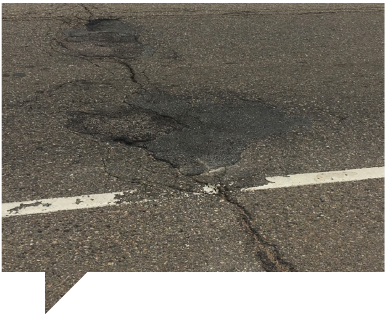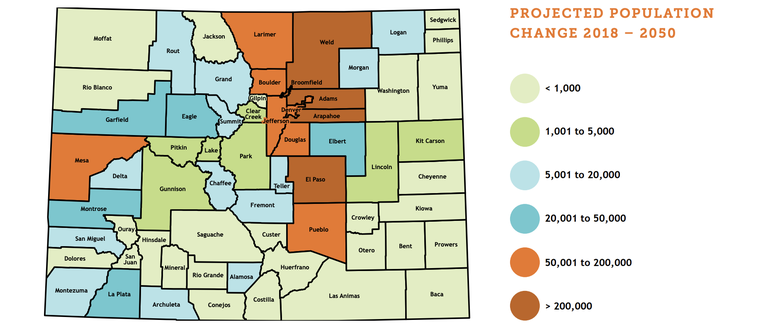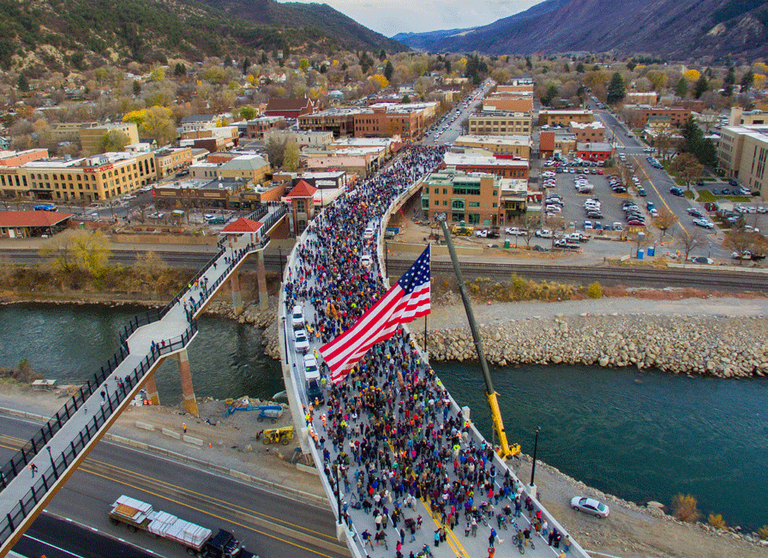Outstanding Needs
Colorado’s Transportation System Today
Road Conditions & Maintenance
The quality of our roads is degrading and continues to get worse. Colorado is one of the most challenging states in the nation to maintain. Each year, CDOT keeps 35 mountain passes and some of the country’s highest elevation roads open year-round, monitors 278 avalanche paths, and plows 6 million lane miles. These difficulties, combined with many years of low funding, are taking its toll on our system. Colorado ranks 28th in the nation for pavement condition on urban interstates and in the bottom five (47th) for pavement condition along rural interstates.

Mobility
More people are using our transportation system and the number will keep rising. Our state population grew by 39 percent (1.59 million) over the last 20 years and is projected to grow another 30 percent (1.69 million) over the next 20 years.2 The Front Range in particular is expected to experience major population growth. As the population increases, so too does the distance many Coloradans need to travel between home and work — resulting in more vehicle travel. Today, Colorado ranks 37th in the nation for traffic congestion, approaching the ranking of states commonly associated with the worst traffic in the nation.1 At the same time, there has been growing recognition that Colorado cannot build its way out of congestion. This has led to an interest in seeking new congestion management solutions, including the creation and growth of Bustang, CDOT’s first statewide transit service, and adding Express Lanes along the most congested corridors.
82-85% of Colorado's population
lives along the Front Range.
- Colorado State Demography Office

Safety
Crash rates and traffic fatalities are increasing. A number of factors contribute to this, but chief among them are driver behaviors. Speeding, impaired driving, distracted driving and a lack of seat belt use are top contributors to injury and fatal crashes. In 2018, there were 632 traffic fatalities in Colorado. This includes:
- 90 pedestrians
- 22 bicyclists
- 103 motorcyclists
- 417 passenger vehicle occupants
With four million licensed drivers in Colorado, one in every 33 Colorado drivers will be in a crash this year.

Funding Challenges
The ever-growing needs of our state’s transportation system cannot be addressed by funding that doesn’t keep pace. Most of CDOT’s funds come from state and federal gas taxes, and those taxes haven’t changed since 1991 — almost 30 years. These taxes are a fixed amount per gallon and do not increase with the price of gas or inflation — meaning that while construction, materials, wages and everything else has increased in cost, the taxes that fund Colorado’s transportation system have stayed the same.
As funding stays stagnant and the population increases, CDOT’s transportation investment per person is reduced over time. In the 1990s, CDOT spent $125 per person on transportation — building and improving highways and bridges, removing snow, improving safety; all the things we want to be able to do. Today, as funding levels stagnate, CDOT spends $81 per person. By 2040, we estimate only spending $48 per person. Comparing our state to the nation, Colorado ranks 33rd in total spending per mile.
Short-term funding increases are helping. Colorado’s legislature has recently passed bills that have temporarily increased CDOT’s budget, allowing us to pursue some improvement projects. Today, this funding is being put to work across the state, including safety, congestion, mobility and road condition improvements of critical segments of I-25 along the Front Range
Legislature-Allocated Funding in Action
In fiscal year 2019, CDOT received more than $800 million in additional funding from the legislature. These dollars, combined with funding contributions from local partners, have been put to work delivering the following projects:
- I-25 South Gap: Monument to Castle Rock
- I-70 Westbound Peak Period Shoulder Lane (Mountain Corridor)
- CO 13 Rio Blanco to Wyoming South
- CO 9 Frisco North
- US 50 Little Blue (Gunnison to Montrose)
- I-25 North Segments 5 & 6 (Mead to Johnstown)
- I-70 Replacing Failing Pavement (Eastern Plains)
- US 160 Towaoc Passing Lanes
- US 550/160 Connection (Durango)
Dedicated Funding in Action
In 2009, Colorado had 128 structurally deficient bridges in need of repair or replacement. That same year, Colorado passed the Funding Advancement for Surface Transportation and Economic Recovery (FASTER) legislation. FASTER created the Colorado Bridge Enterprise and provided a designated funding source for bridge repairs and replacements.
Motorists have likely seen the “BRIDGE FEE” that is on vehicle registration documents. That fee — which ranges from $13 to $32 based on vehicle weight — generates approximately $100 million in annual funding to improve or replace bridges.
The Result?
- Bridge Enterprise funding has been programmed to repair or replace 161 structures statewide. This dedicated funding source will allow CDOT to continue addressing structurally deficient bridges in the future.
- Colorado ranks 19th in the nation when it comes to the number of structurally deficient bridges. That’s better than nearly two-thirds of all states.

Successful Bridge Enterprise Projects
- Grand Avenue Bridge in Glenwood Springs
- Ilex Project in Pueblo (8 bridges)
- Pecos Street over I-25 in Denver
- CO 90 over the Dolores River in Montrose County
- CO 59 over I-70 in Kit Carson County
- US 287 over railroad at 69th Avenue in Adams County
- US 6 Design-Build Project in Denver (3 bridges)
